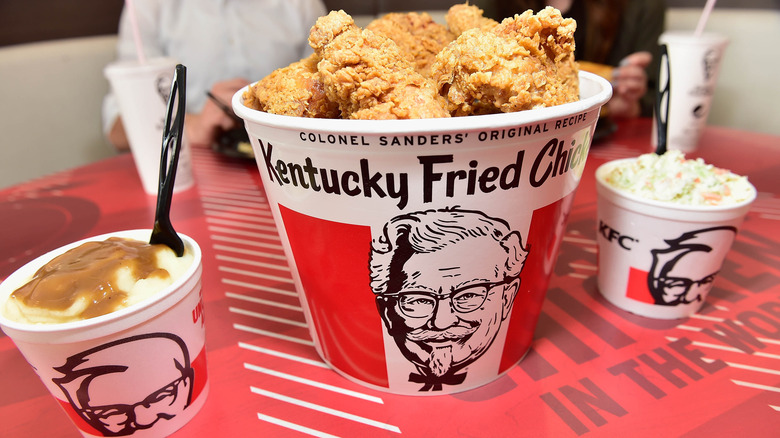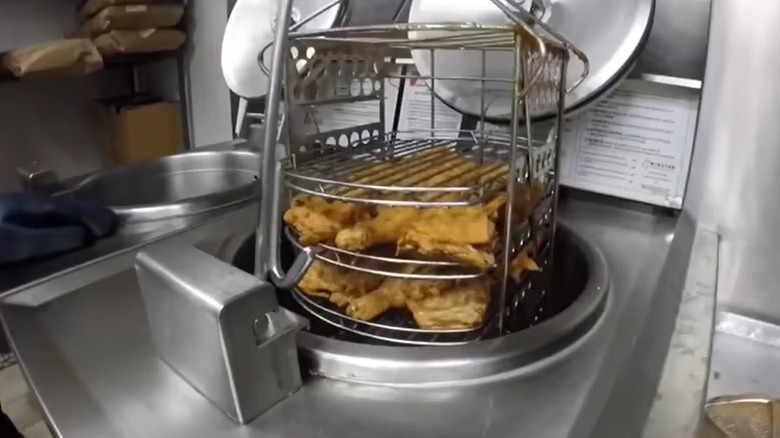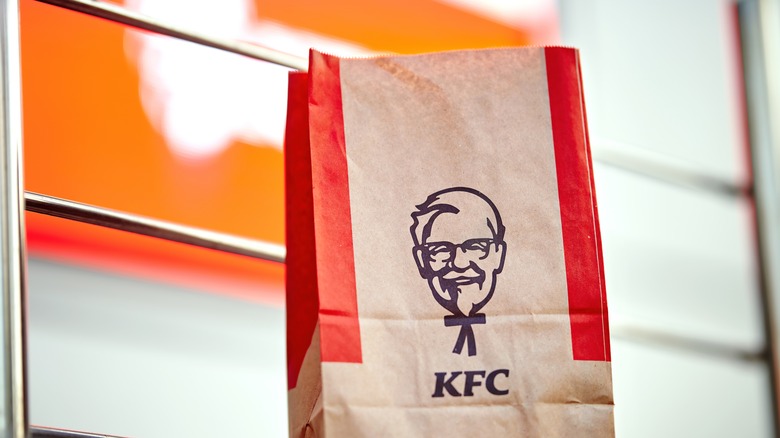The High-Tech Fryer Behind KFC's Chicken And How To Replicate It At Home
What do you think of when you think of KFC? Maybe you think of drumsticks, breasts, and tenders served alongside a heaping bowl of mashed potatoes. Maybe you're even thinking of the infamous Double Down sandwich and all of its deep-fried cheesy splendor. Whatever comes to mind, it always boils down to one simple fact: KFC sells fried chicken and it's pretty darn good at what it does.
Because of KFC's popularity in the fast-food industry, it should come as no surprise that there are people who want to try and replicate the secret recipe that has propelled the chicken chain into deep-fried history. There are many copycats out there that, to their credit, do result in a mean piece of fried chicken. Yet, nothing seems to exactly match how KFC prepares its chicken — even with the supposed recipe being "leaked" or "accidentally revealed" on more than one occasion. As it stands, people have yet to crack the famous "secret recipe," no matter how many times they experiment with the fabled 11 herbs and spices.
But maybe it's not just the herbs and spices that have made KFC's chicken so famous. Perhaps the answer lies more in the tools that are used to fry the chicken itself. If the stories are to be believed, the secret may lie within an impressively powerful deep-fryer. What makes this fryer so unique and how can you, if possible, replicate its effects at home?
KFC has industrial-strength fryers
When you want something to be crispy, you add heat. When you want something to be extra crispy, you put as much heat on that bad boy as possible. If the equation of "heat plus food equals crisp" can be considered a golden rule, then KFC seems to hold steadfast to this culinary formula.
KFC is in possession of multiple industrial-strength pressure fryers that can quickly crispen the skin of any piece of chicken put in it. This makes sense, considering just how many KFC restaurants there are and how many people said locations serve each day. Customers would want their chicken hot and ready the moment they get into the store, so loading up on massive industrial fryers would be the only way to go.
The supplier of these industrial fryers is Winston Foodservice. Two of the models used by KFC are the "Collectramatic Fryer" and the "CVap Holding Cabinets," which have been used in restaurants for over 50 years. In fact, as the story goes, founder Winston Shelton was inspired by Colonel Sander's "genius" to develop the Collectramatic Fryer, basing the model on Sander's vision of frying chicken in a home canner. Although the process of getting the fryer model into the restaurants nationwide was a struggle, to the point Sanders himself had to help stave off financial troubles for Shelton, the Collectramatic Fryer is in use at thousands of KFC restaurants to this day.
How can you replicate those fryer at home?
Unless you're willing to shell out a few thousand dollars for an industrial fryer or are inclined enough to design your own, you can't replicate KFC's machinery. Your usual fryer or pressure cooker may not be able to reach the extreme heat needed to fry the chicken as effectively as KFC"s fryers will. But this doesn't necessarily mean you can't implement the delicious crunch you get with KFC's chicken in your own home.
A very simple method for doing this is to fill your deep fryer (if you don't have a deep fryer, a Dutch oven or any sort of heavy pot will also work just fine) with oil. Allow the oil to heat between 350 and 360 degrees before adding your chicken pieces. Leave each piece of chicken in for around 12 minutes before removing to drain on paper towels. You can let your chicken cool off for a few minutes, or you can finish baking the chicken in a 175-degree oven for 20 minutes before serving. The oven method not only helps keep the chicken warm while the rest of the chicken finishes frying but also helps to keep the skin crispy instead of soggy as it drains.
While you may not be able to replicate the exact crunch and texture of KFC in your home, considering the lack of industrial equipment, you can still achieve a very crunchy and delicious exterior on your fried chicken nonetheless.


